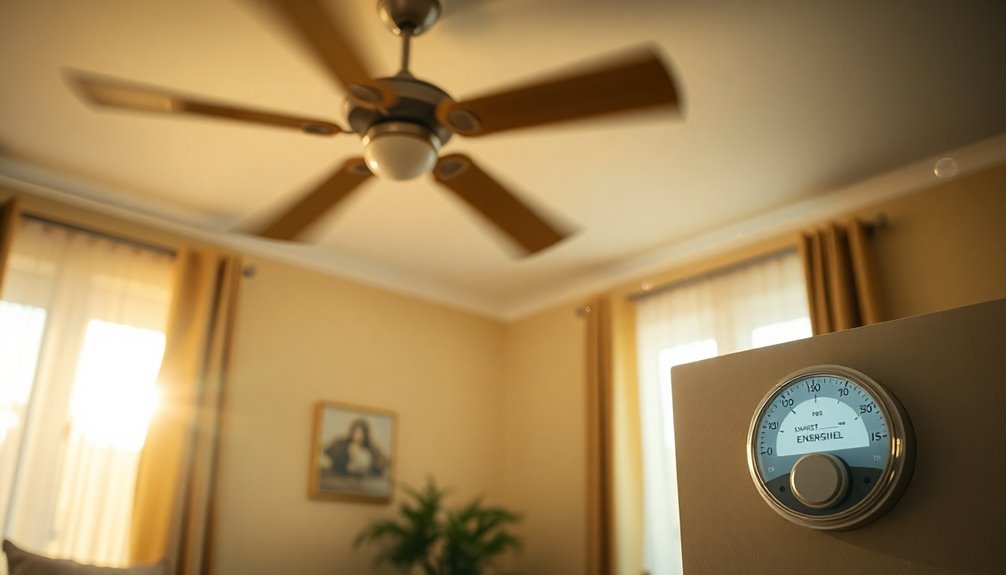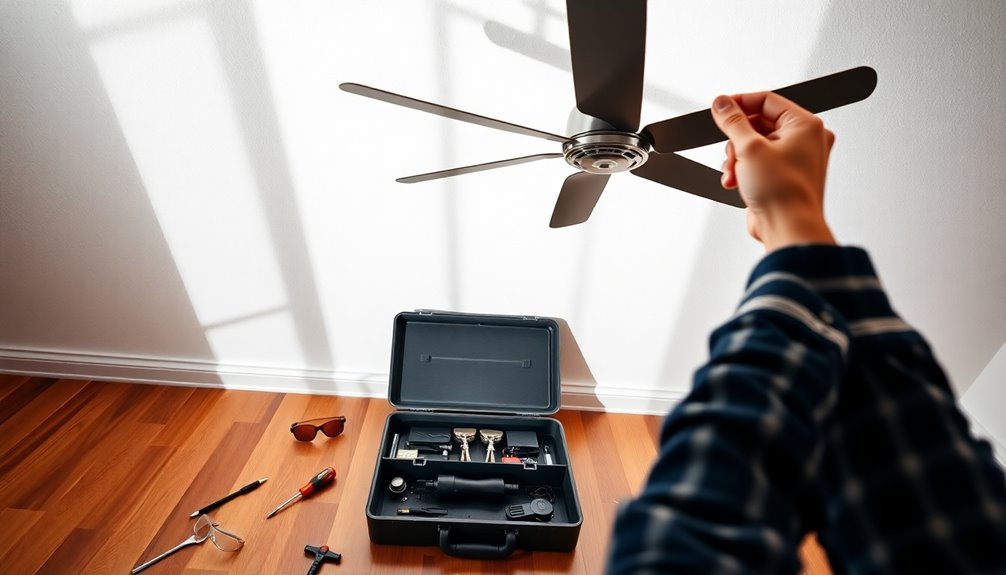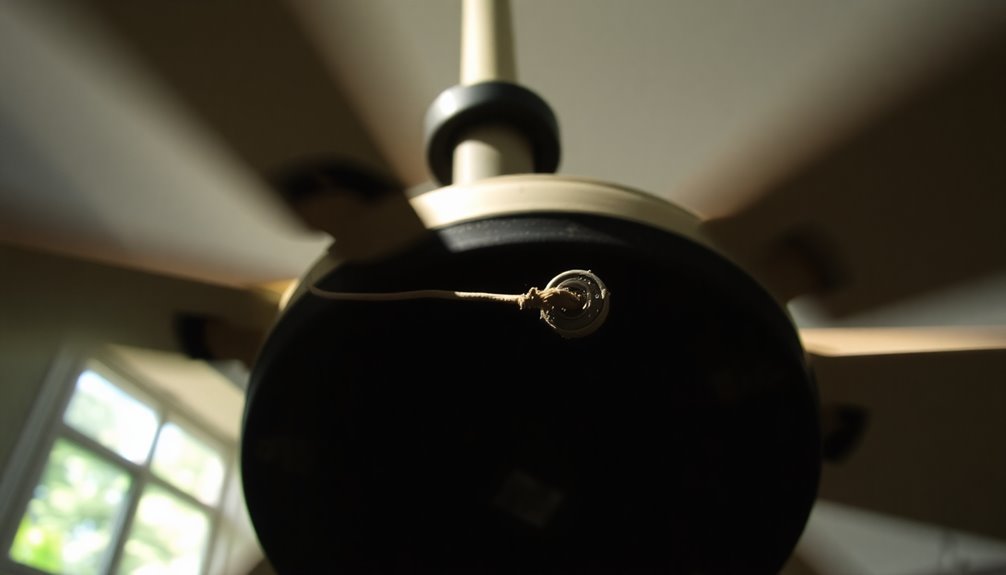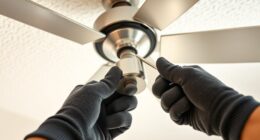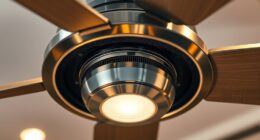To keep cool in summer, you need to set your ceiling fan to rotate counterclockwise. This direction creates a revitalizing downdraft, improving air circulation and making you feel cooler without lowering the thermostat. You can even raise the thermostat by about 4 degrees, saving on energy costs. For the best effect, verify the fan blades are angled at a minimum of 12 degrees, and adjust the speed based on your room size. Don't forget to switch the fan direction back for winter use! Stick around to uncover more tips for optimizing your fan's performance and efficiency.
Key Takeaways
- Set the ceiling fan to rotate counterclockwise in summer for optimal cooling and enhanced air circulation.
- A counterclockwise direction creates a cooling downdraft, allowing you to raise the thermostat by about 4°F.
- Ensure the fan's blade angle is at least 12 degrees for effective airflow and comfort.
- Ceiling fans use significantly less energy than air conditioning, costing approximately $0.01 per hour to operate.
- Regularly adjust the fan direction with the seasons to maximize energy savings and maintain comfort.
Importance of Ceiling Fan Direction

Understanding the importance of ceiling fan direction can make a significant difference in your home's comfort and energy efficiency.
In summer, setting your fan to rotate counterclockwise is vital. This rotation creates a cooling downdraft that enhances air circulation, making you feel cooler without cranking up the air conditioning. By keeping the fan in this position, you can comfortably raise your thermostat by about 4 degrees, potentially saving energy costs by up to 30%.
When you optimize your ceiling fan direction, you're not just improving your comfort; you're also complementing your HVAC system, which can lead to further energy savings. Proper air circulation helps maintain a consistent room temperature, reducing the strain on your cooling system. This means not only a cooler home but also a more efficient one.
Regularly adjusting your ceiling fan direction according to the season is essential. In summer, the counterclockwise setting maximizes cooling and minimizes energy consumption, allowing you to save energy effortlessly.
Summer Fan Direction Guidelines

To maximize your comfort during the hot summer months, it's important to follow specific guidelines for ceiling fan direction.
Set your ceiling fan to rotate in a counterclockwise motion. This rotation creates a cooling downdraft that enhances airflow, making your space feel much cooler. You'll experience a noticeable wind chill effect, so even though the air temperature remains the same, the perceived coolness increases.
When adjusting your fan, make sure the blades have a minimum angle of 12 degrees for ideal performance. This angle is vital for maximizing airflow while keeping you comfortable.
If you have outdoor fans, use the same counterclockwise direction to improve your outdoor comfort during those hot summer days.
Energy Savings With Ceiling Fans

Using your ceiling fan in summer can lead to considerable energy savings.
By setting it to rotate counterclockwise, you'll create a rejuvenating breeze that lets you raise your thermostat by about 4 degrees, cutting cooling costs considerably.
This simple adjustment not only enhances your comfort but also reduces your reliance on air conditioning.
Summer Fan Rotation Benefits
One of the most effective ways to enhance your comfort and save on energy costs during the sweltering summer months is by correctly setting your ceiling fan to rotate counterclockwise. This ceiling fan direction creates a cooling downdraft, delivering a revitalizing wind chill effect that makes the heat more bearable.
By optimizing your fan's airflow, you can feel cooler without cranking up the air conditioning. When your ceiling fan runs counterclockwise, it helps circulate air more efficiently, allowing you to raise your thermostat settings by about 4 degrees.
This simple adjustment can greatly reduce your air conditioning costs, as operating a ceiling fan consumes only about 50 watts compared to the 3,500 watts used by an AC unit. In fact, properly using your ceiling fan can lead to energy savings of up to 30%, making it a smart choice for summer cooling.
To maximize these benefits, verify the fan blades are angled at a minimum of 12 degrees. This angle promotes effective airflow, enhancing the cooling experience while helping you save money and energy during the hottest months of the year. Additionally, using ceiling fans in conjunction with air purifiers can further improve indoor air quality and comfort during the summer months by reducing allergens and enhancing overall air circulation.
Reduced Air Conditioning Costs
Reducing air conditioning costs can be as simple as adjusting your ceiling fan's direction. When you set your ceiling fan to rotate counterclockwise, it creates a cooling downdraft, allowing you to raise your thermostat settings by about 4 degrees. This can lead to significant energy savings.
Here are three key benefits of using your ceiling fan wisely:
- Cost-effective cooling: Operating a ceiling fan costs about $0.01 per hour, while air conditioning can range from $0.12 to $1.13.
- Enhanced energy efficiency: Using ceiling fans alongside ENERGY STAR-rated air conditioning units can boost overall efficiency by up to 8%.
- Reduced reliance on AC: By maintaining a consistent room temperature and rotating your fan counterclockwise, you can lower your air conditioning use by up to 30%.
With just a simple adjustment, you can enjoy cool air while saving on your utility bills. Additionally, using ceiling fans in conjunction with geothermal heat pumps can further enhance your home's overall energy efficiency.
Keep your fan speed steady, and you'll notice the difference in your energy savings, making your home a more comfortable place to be during hot summer months.
Enhancing Indoor Comfort Levels
Adjusting your ceiling fan's direction can dramatically enhance indoor comfort levels during the sweltering summer months. By setting your ceiling fan to rotate counterclockwise, you create a revitalizing downdraft that increases air movement and lowers the perceived temperature in your space.
This simple adjustment makes a significant difference, especially when you consider that you can raise your thermostat settings by about 4 degrees without sacrificing comfort.
Not only does this improve your comfort, but it also leads to impressive energy savings. Operating a ceiling fan costs roughly $0.01 per hour, compared to $0.12 to $1.13 for air conditioning units. By using a ceiling fan effectively, you could save up to 30% on cooling costs.
Additionally, pairing your ceiling fan with an ENERGY STAR-rated air conditioning system can enhance overall energy efficiency by up to 8%. This combination optimizes both cooling performance and cost savings, allowing you to combat warm air without breaking the bank.
Changing Ceiling Fan Direction

Changing the direction of your ceiling fan for summer is a simple yet effective way to enhance comfort in your home. By adjusting the ceiling fan direction, you can maximize airflow and create a cooling downdraft that makes a noticeable difference.
Here are three key benefits to evaluate:
- Improved Comfort: Setting your fan to rotate counterclockwise creates a rejuvenating breeze that cools down your space.
- Energy Savings: You can raise your thermostat setting by about 4 degrees, leading to significant savings on your cooling costs.
- Easy Control: If you have a remote-controlled fan, simply use the remote or app to change the ceiling fan direction to counterclockwise.
To change ceiling fan direction, make sure the fan is off and has stopped completely before adjusting the switch, usually located on the motor housing.
If you're using a remote-controlled fan, follow the manufacturer's instructions to toggle the direction setting.
Once you've set it to counterclockwise, stand underneath to confirm you feel the cool air being pushed downwards.
This small adjustment can greatly enhance your summer comfort!
Optimal Fan Speed Settings

To achieve ideal cooling with your ceiling fan, you'll want to take into account the recommended speed settings based on your room size.
For smaller spaces, a medium speed may suffice, while larger rooms often benefit from higher settings.
Adjusting the fan speed according to the temperature and humidity can enhance comfort and efficiency.
Recommended Speed Settings
Finding the right fan speed can make all the difference in your summer comfort. By adjusting your ceiling fan's speed settings properly, you can achieve ideal cooling while maximizing energy savings.
Here are three key points to take into account:
- High Speed for Larger Rooms: Set your ceiling fan to high speed, rotating counterclockwise. This creates a revitalizing downdraft, enhancing the wind chill effect to keep you cool.
- Medium Speed for Smaller Spaces: In smaller rooms, a medium speed may suffice. This still provides adequate airflow without causing discomfort.
- Energy Efficiency: Operating a ceiling fan costs about $0.01 per hour. By running it at high speed, you can raise your thermostat by 4 degrees Fahrenheit, leading to significant savings on air conditioning.
Adjusting for Room Size
Understanding your ceiling fan's ideal settings based on room size can greatly enhance your comfort during the sweltering summer months. For rooms up to 300 square feet, set your ceiling fan to high speed and guarantee it rotates counterclockwise. This maximizes air circulation and creates a revitalizing cool breeze. In smaller spaces, a medium fan speed might provide sufficient airflow without overwhelming you.
If you're dealing with larger rooms over 500 square feet, one fan may not be enough. You might need multiple fans to guarantee proper air circulation. Adjusting the fan speed based on room size and occupancy can lead to impressive energy savings of up to 30%, reducing your reliance on air conditioning.
Additionally, make sure your fan's blades are angled at least 12 degrees to optimize airflow and efficiency. This helps in circulating air effectively, creating a comfortable environment.
Ceiling Fan Use in Different Rooms

Ceiling fans play an essential role in enhancing comfort across different rooms during the summer months. Understanding the best way to use them can greatly elevate your indoor experience. Here are three key areas to take into account:
- Living Room: Set your ceiling fan to turn counterclockwise for a invigorating downdraft, allowing you to raise your thermostat by about 4 degrees without sacrificing comfort.
- Dining Room: Keep the fan on high speed, rotating counterclockwise, to create a pleasant atmosphere while dining. It feels cooler without impacting the temperature of your food.
- Home Offices: For long hours of work, maintain your fan on a medium setting, still turning counterclockwise. This prevents papers from blowing around while providing a cooling breeze.
In spaces with vaulted ceilings, it's wise to keep your fan spinning counterclockwise year-round to guarantee proper air circulation without excessive wind chill.
Additionally, don't forget your outdoor ceiling fan; it should also turn counterclockwise during summer to enhance comfort and help control insects.
Common Mistakes to Avoid

Using ceiling fans effectively can be a game-changer for your summer comfort, but many people make common mistakes that reduce their efficiency.
One major error is forgetting to switch the ceiling fan direction to counterclockwise. This setting creates a cooling downdraft, maximizing your comfort. Additionally, don't underestimate fan speed; running your fan at high speed is often necessary to optimize the cooling effect during hot weather.
Another common mistake is neglecting to check the blade angle. Confirming a minimum blade angle of 12 degrees is essential for proper airflow. Remember, ceiling fans don't cool the air; they cool people by circulating air. So, turn off the fan when you leave a room to save energy.
Lastly, ignoring fan maintenance, like cleaning the blades, can notably hinder performance. Dusty blades can obstruct airflow and reduce efficiency.
Benefits of Proper Fan Maintenance

Proper fan maintenance isn't just about keeping things tidy; it's key to enhancing energy efficiency and improving airflow performance.
By regularly cleaning the blades and checking for loose screws, you can boost your fan's effectiveness considerably.
This simple upkeep helps you enjoy cooler air while saving on energy bills.
Enhancing Energy Efficiency
How can regular maintenance of your ceiling fan boost energy efficiency? Keeping your fan in tip-top shape can greatly enhance airflow and reduce your energy consumption.
Here are three key benefits of proper maintenance:
- Clean Blades: Dust and dirt can accumulate on the fan blades, hindering performance. Regularly cleaning them guarantees maximum airflow and prevents excessive energy use.
- Motor Functionality: Checking the fan's motor guarantees it operates efficiently. A well-maintained motor can help you save up to 30% on cooling costs during the summer.
- Proper Alignment: Confirming your blades are aligned at the correct angle (a minimum of 12 degrees) maximizes airflow. This adjustment enhances the cooling effect and contributes to overall energy savings.
Additionally, maintaining your ceiling fan can help reduce reliance on air conditioning, as it enhances airflow and allows you to raise your thermostat temperature by several degrees.
Improving Airflow Performance
Improving airflow performance in your home starts with regular ceiling fan maintenance, which can greatly enhance cooling effectiveness. Keeping your ceiling fans in prime condition not only boosts airflow efficiency but also maximizes your home's cooling performance.
Here's how proper maintenance can make a difference:
| Maintenance Action | Impact on Airflow Performance |
|---|---|
| Regular cleaning of blades | Improves airflow efficiency by up to 30% |
| Confirming a 12-degree blade angle | Maximizes airflow and cooling performance |
| Checking installation clearance | Prevents airflow obstruction for better circulation |
When you confirm your ceiling fan has at least 10 inches of clearance from the ceiling, it allows for better air circulation. Regularly checking for loose screws and bolts also helps maintain fan stability, reducing vibrations that can hinder airflow performance. By performing routine maintenance, like cleaning and adjusting fan direction, you can extend the lifespan of the fan while enhancing energy efficiency. So, take the time to keep your ceiling fans well-maintained for peak cooling during those hot summer months.
Complementing Ceiling Fans With AC

Combining the cooling power of ceiling fans with your air conditioning unit can greatly enhance your comfort during the sweltering summer months. When you complement these two systems, you not only enjoy a more pleasant environment but also reap significant benefits:
- Energy Efficiency: Pairing ceiling fans with an ENERGY STAR-rated air conditioning unit can boost cooling efficiency by up to 8%, helping you save on energy costs.
- Cost Reduction: Using ceiling fans can lower your cooling costs by as much as 30%, as they effectively circulate cool air throughout the room.
- Comfort Control: Running your ceiling fan counterclockwise allows you to raise your thermostat by about 4 degrees without sacrificing comfort.
To maximize these benefits, remember to regularly adjust the fan direction. In summer, keep your ceiling fans turning counterclockwise to create a cooling downdraft.
This simple adjustment enhances airflow and guarantees a consistent indoor temperature. Since ceiling fans consume only about 50 watts compared to the 3,500 watts of typical air conditioning units, you'll experience substantial energy savings while enjoying a comfortably cool home.
Additional Tips for Efficiency

To make the most of your ceiling fan's efficiency, regular maintenance is key. Start by cleaning the ceiling fan blades and motors to enhance airflow efficiency and reduce energy consumption. Verify your fan is appropriately sized for the room; larger spaces may require multiple ceiling fans for maximum cooling effectiveness.
Utilize ceiling fans in conjunction with open windows to boost cross-ventilation and improve indoor air quality. Consider investing in smart fans that automatically adjust speed and direction based on temperature and season—these can lead to significant energy savings. With the right setup, you can raise your thermostat settings by up to 4 degrees, potentially cutting air conditioning costs by up to 30%. Additionally, similar to how home security systems can provide tailored solutions for different properties, ensuring your fan is suited to your specific space can optimize its performance.
Here's a quick reference table to help you remember these efficiency tips:
| Tip | Benefit | Action |
|---|---|---|
| Clean blades and motors | Better airflow efficiency | Schedule regular cleaning |
| Choose the right size | Effective cooling | Measure room dimensions |
| Open windows | Improved indoor air quality | Keep them open when using fans |
| Invest in smart fans | Automatic adjustments | Explore smart fan options
Frequently Asked Questions
How Can You Tell if a Fan Is Going Clockwise or Counterclockwise?
To tell if a fan's going clockwise or counterclockwise, stand directly beneath it.
If the blades move to the right, it's rotating clockwise; if they move to the left, it's counterclockwise.
You can also feel the airflow: a breeze indicates counterclockwise rotation, while a gentle upward flow suggests clockwise.
Check for a reversing switch on the motor housing to change the direction if needed, especially when the fan's turned off.
Which Way Should a Ceiling Fan Turn in Summer Reddit?
If you're wondering which way your ceiling fan should turn in summer, it's best to have it rotate counterclockwise.
This direction creates a cooling downdraft, pushing cooler air down into your space. You'll feel an invigorating breeze, making you feel cooler without lowering the temperature.
Plus, running your fan in this way can help save on air conditioning costs, so you can enjoy a comfortable environment without breaking the bank.
How Does a Ceiling Fan Rotate Clockwise or Anticlockwise?
Imagine you're in a cozy room, a retro record player spinning your favorite tunes.
You can change a ceiling fan's rotation easily. Just locate the switch on the fan motor or use the remote control if it's a smart fan.
When the blades move clockwise, they push warm air down; counterclockwise, they create a cooling breeze.
What Does the Winter Setting on the Fan Do?
The winter setting on your ceiling fan rotates the blades clockwise at a low speed. This gentle updraft helps redistribute warm air trapped near the ceiling back down into your living space.
Conclusion
By setting your ceiling fan to spin counterclockwise in the summer, you can create a rejuvenating breeze that makes you feel like you're lounging on a beach, even indoors. This simple adjustment not only enhances comfort but also saves energy, keeping your utility bills in check. Remember, a little maintenance goes a long way. So, embrace the cool, and let your ceiling fan work its magic while you enjoy summer's warmth without breaking a sweat.

